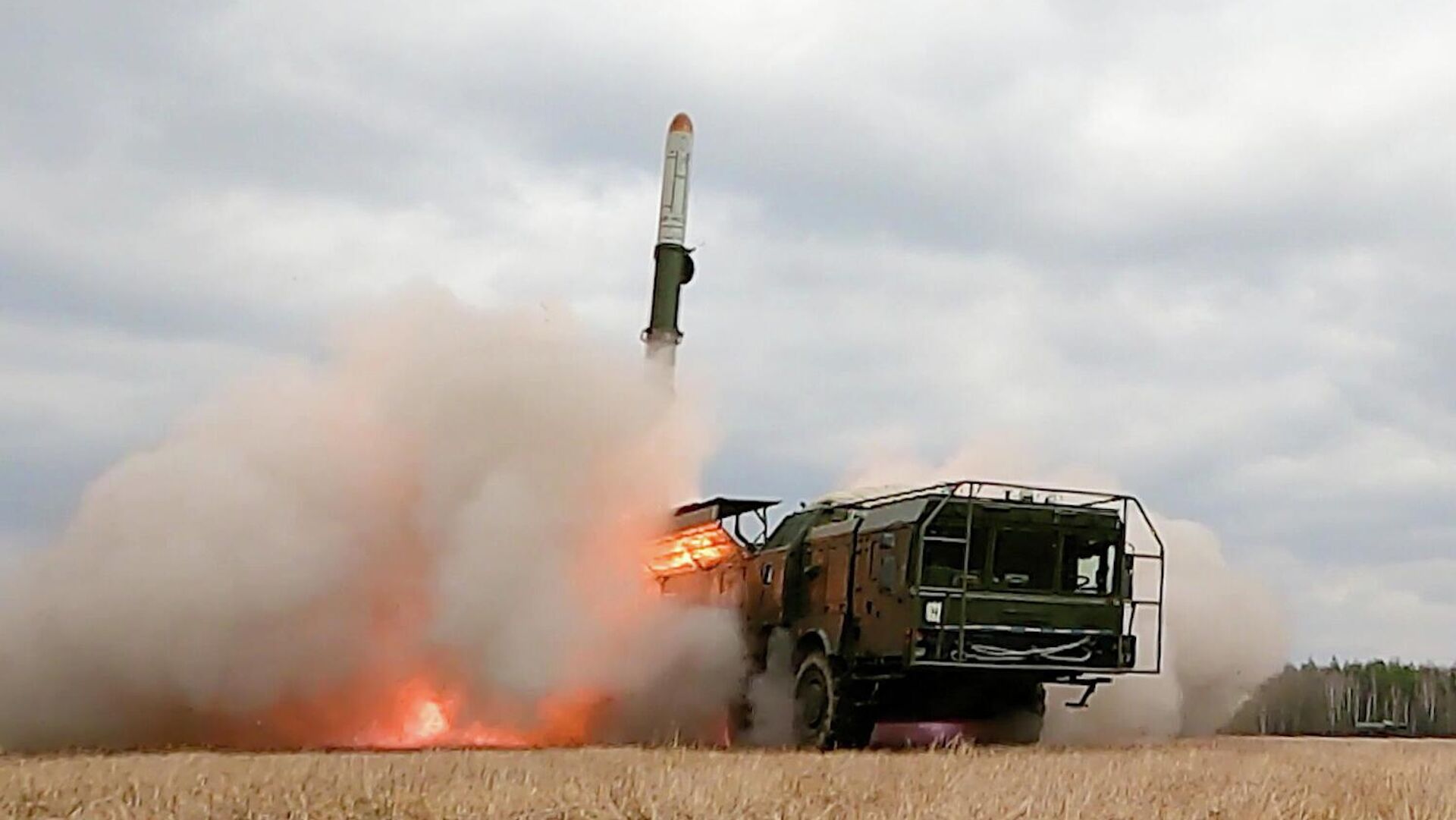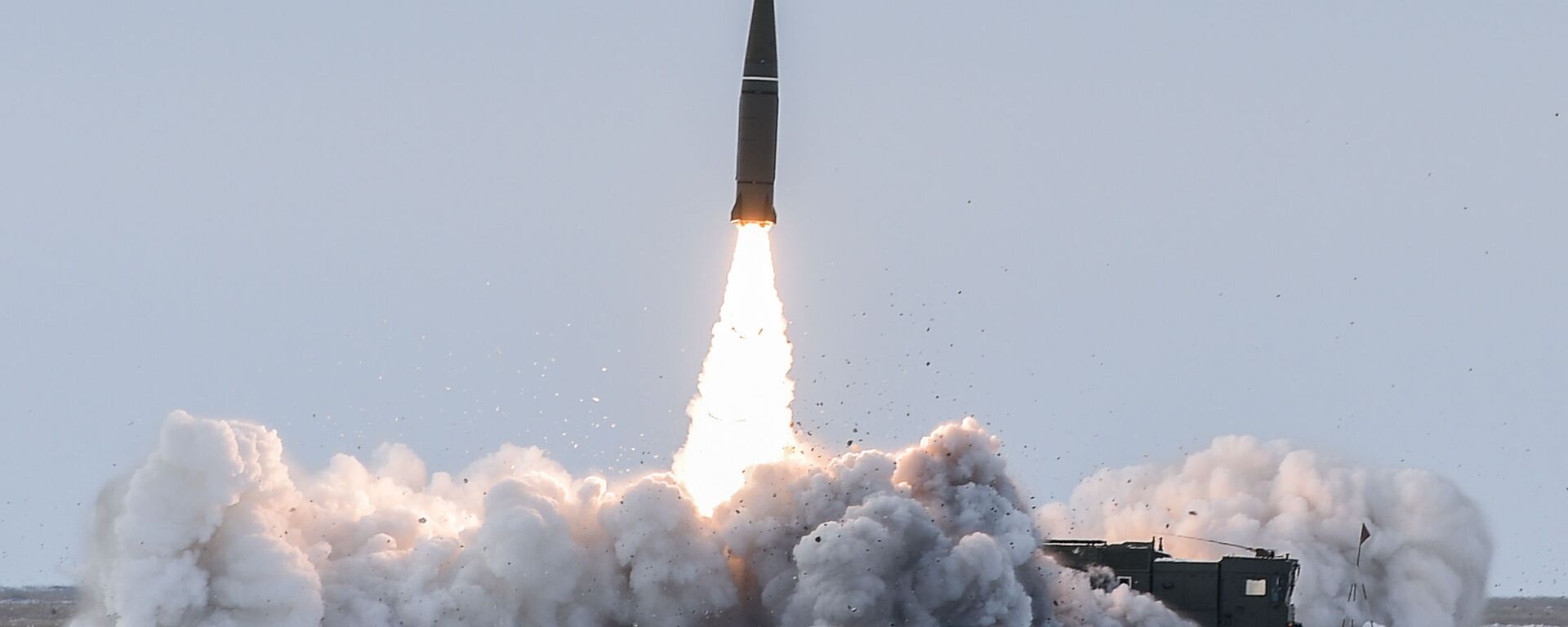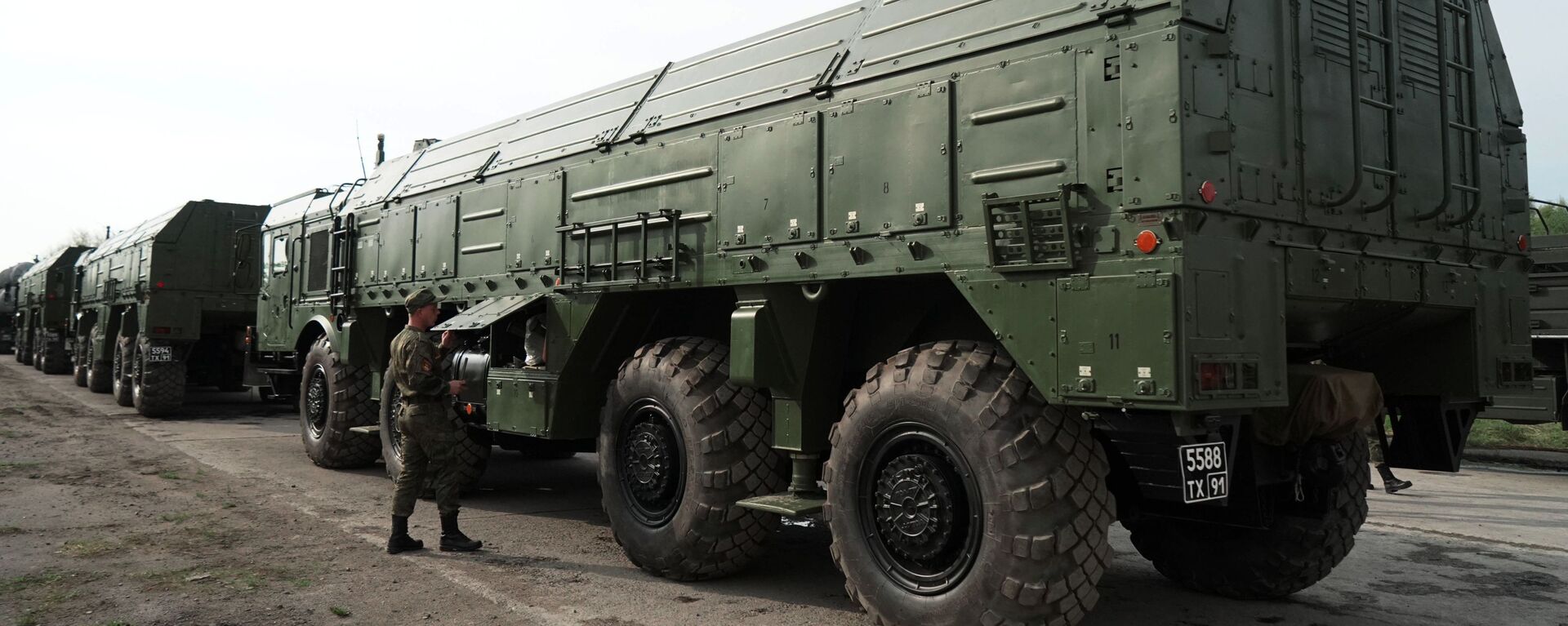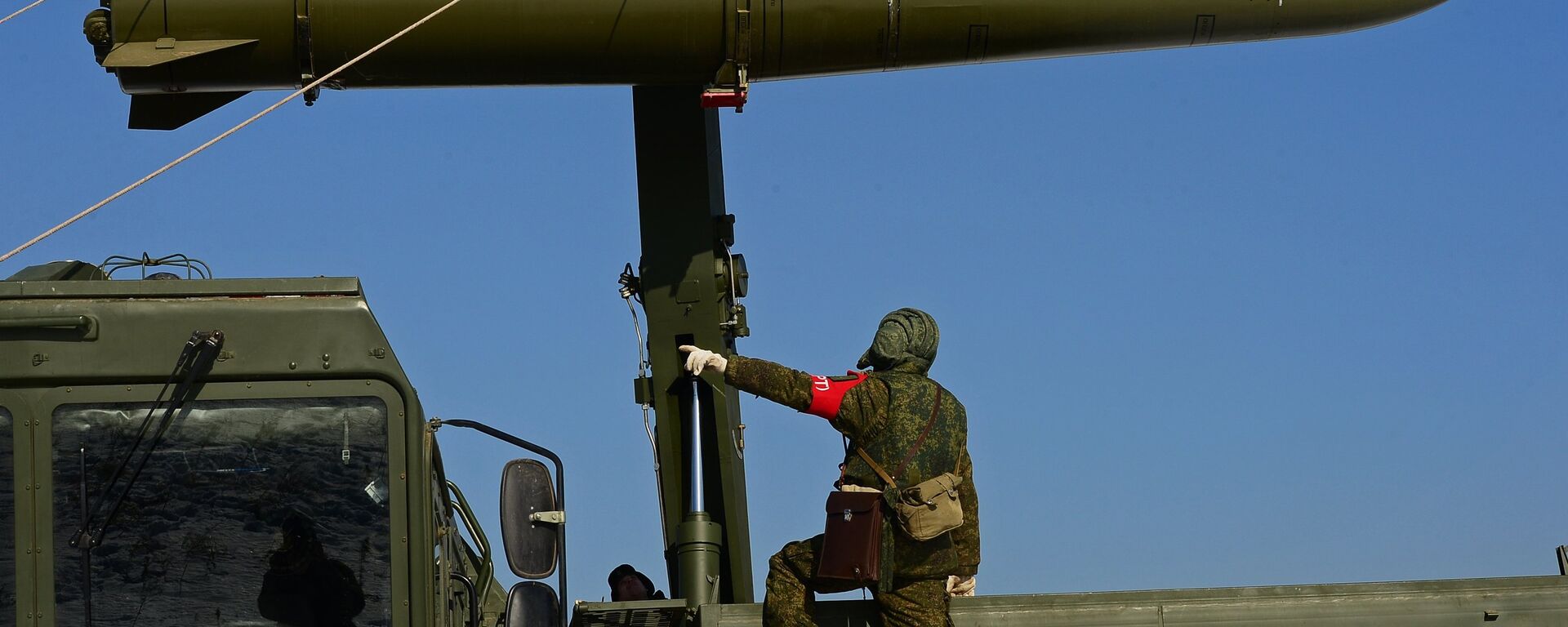https://sputnikglobe.com/20230707/how-russian-tactical-nuclear-weapons-ensure-belarus-national-security-1111729104.html
How Russian Tactical Nuclear Weapons Ensure Belarus National Security
How Russian Tactical Nuclear Weapons Ensure Belarus National Security
Sputnik International
Russia has delivered several batches of tactical nuclear weapons to Belarus by July 7 in accordance with the earlier announced agreement between the two allied nations. On Thursday, President of Belarus Alexander Lukashenko announced that these arms are under reliable protection.
2023-07-07T17:37+0000
2023-07-07T17:37+0000
2023-07-07T17:37+0000
military
belarus
russia
minsk
dmitry kornev
vladislav shurygin
alexander lukashenko
society
nato
nuclear weapons
https://cdn1.img.sputnikglobe.com/img/07e6/05/04/1095255381_0:213:1496:1056_1920x0_80_0_0_73ad729725a0601f29d8034ad48c2486.jpg
He stressed that Belarus is not going to launch nuclear weapons at anyone, explaining that the tactical atomic arms are intended solely for defensive purposes. "If [the West] commits aggression against Belarus, the response will be instantaneous. The goals have already been determined," Lukashenko said while addressing the press.Western countries pose a threat to Belarus especially after Minsk indicated its support for Russia over the latter's special military operation in Ukraine, according to military experts Dmitry Kornev and Vladislav Shurygin.One should also bear in mind that a few years ago, hostile forces tried to foment a color revolution in Belarus with the West's assistance, he pointed out.A series of political protests in Belarus erupted on 9 August 2020 and lasted until March 2021. Later, Russian scholars drew attention to the hybrid nature of the political turmoil which turned out to be an attempted coup d'etat. They noted that the so-called "Belarusian Spring" resembled nothing so much as a testing ground for the latest practice of "color revolutions", as it appeared to be a "fusion" of the technologies of the Kiev Euromaidan (2013-2014), protests in Hong Kong (2019-2020) and the Venezuelan precedent (2019), according to a study by Professor Andrey Manoilo, a political scientist from Lomonosov Moscow State University."Since Belarus actually took Russia's side in the present confrontation between Russia and NATO over the special military operation [in Ukraine], there may be certain fears [in Minsk] that the Western bloc may turn into a potential adversary of the government in Belarus," Kornev, who is also a founder of the Military Russia portal, told Sputnik.Stationing Russia's tactical nuclear weapons in the territory of Belarus could serve as a "stop-factor" for the West, Kornev noted. In some sense it's a guarantee that the West will not attack Belarus while it is armed with Russian nuclear weapons, he added.How Could Russian Nuclear Weapons Affect the Balance of Power?There is nothing new about Russia's decision to deploy its nuclear weapons in Belarus: for years the US tactical nuclear weapons have remained at six bases in five NATO member countries in Europe, namely, Belgium, Germany, Italy, the Netherlands, and Turkiye.Still, one might ask whether stationing of Russian nuclear warheads changes the existing status quo in the region.According to Kornev, placing Russian tactical nuclear weapons closer to the present NATO borders "changes the strategic balance [in the region] to a certain extent".Earlier this month Belarusian President Lukashenko expressed confidence that the tactical nuclear weapons stationed in Belarus would never be used, adding that they must nevertheless remain in the country."I'm sure that as long as they are here, we will never have to use them, and no enemy soldier will ever set foot on our land," the president emphasized.
https://sputnikglobe.com/20230706/lukashenko-says-nuclear-warheads-to-be-completely-moved-to-belarus-in-2023-1111701168.html
https://sputnikglobe.com/20230531/minsk-believes-deploying-russian-tactical-nuclear-arms-to-cool-down-war-like-rhetoric-1110813981.html
https://sputnikglobe.com/20230528/stationing-tactical-nuclear-weapons-in-belarus-meant-as-containment-measure---minsk-1110756931.html
belarus
russia
minsk
poland
lithuania
latvia
estonia
ukraine
Sputnik International
feedback@sputniknews.com
+74956456601
MIA „Rossiya Segodnya“
2023
News
en_EN
Sputnik International
feedback@sputniknews.com
+74956456601
MIA „Rossiya Segodnya“
Sputnik International
feedback@sputniknews.com
+74956456601
MIA „Rossiya Segodnya“
russian tactical nuclear weapons, russian tactical nuclear weapons stationed in belarus, belarus nuclear weapons, nuclear weapons in belarus as deterrence, west poses security challenge to belarus, western-backed political unrest in belarus, alexander lukashenko, vladimir putin
russian tactical nuclear weapons, russian tactical nuclear weapons stationed in belarus, belarus nuclear weapons, nuclear weapons in belarus as deterrence, west poses security challenge to belarus, western-backed political unrest in belarus, alexander lukashenko, vladimir putin
How Russian Tactical Nuclear Weapons Ensure Belarus National Security
Russia delivered several batches of tactical nuclear weapons to Belarus by 7 July in accordance with the agreement between the two allies. On Thursday, the President of Belarus Alexander Lukashenko announced that these arms are being reliably protected.
He stressed that Belarus is not going to launch nuclear weapons at anyone, explaining that the tactical atomic arms are intended solely for defensive purposes. "If [the West] commits aggression against Belarus, the response will be instantaneous. The goals have already been determined," Lukashenko said while addressing the press.
Western countries pose a threat to Belarus especially after Minsk indicated its support for Russia over the latter's special military operation in Ukraine, according to military experts Dmitry Kornev and Vladislav Shurygin.
"In the West, Belarus is surrounded by countries, or, more precisely, adjoined by countries that consider Russia a likely adversary," Shurygin told Sputnik. "These are Poland, the Baltic countries, and Ukraine. Therefore, of course, it's absolutely logical [for Belarus] to be concerned about its safety."
One should also bear in mind that a few years ago, hostile forces tried to foment a color revolution in Belarus with the West's assistance, he pointed out.
A series of political protests in Belarus erupted on 9 August 2020 and lasted until March 2021. Later, Russian scholars drew attention to the hybrid nature of the political turmoil which turned out to be an attempted coup d'etat. They noted that the so-called "Belarusian Spring" resembled nothing so much as a testing ground for the latest practice of "color revolutions", as it appeared to be a "fusion" of the technologies of the Kiev Euromaidan (2013-2014), protests in Hong Kong (2019-2020) and the Venezuelan precedent (2019), according to a study by Professor Andrey Manoilo, a political scientist from Lomonosov Moscow State University.
"Since Belarus actually took Russia's side in the present confrontation between Russia and NATO over the special military operation [in Ukraine], there may be certain fears [in Minsk] that the Western bloc may turn into a potential adversary of the government in Belarus," Kornev, who is also a founder of the Military Russia portal, told Sputnik.
Stationing Russia's tactical nuclear weapons in the territory of Belarus could serve as a "stop-factor" for the West, Kornev noted. In some sense it's a guarantee that the West will not attack Belarus while it is armed with Russian nuclear weapons, he added.
"Now Belarus is under a specific Russian nuclear shield," echoed Shurygin. "That is, any military threat to Belarus automatically means Russia's involvement in this conflict. And, accordingly, this is a conflict with a nuclear power."
How Could Russian Nuclear Weapons Affect the Balance of Power?
There is nothing new about Russia's decision to deploy its nuclear weapons in Belarus: for years the
US tactical nuclear weapons have remained at six bases in five NATO member countries in Europe, namely, Belgium, Germany, Italy, the Netherlands, and Turkiye.
Still, one might ask whether stationing of Russian nuclear warheads changes the existing status quo in the region.
"The fact is that on the territory of Belarus, the Belarusian armed forces will probably be able to use these nuclear warheads, which will be deployed there, if the move is green-lighted by the Russian Federation," Kornev assumed. "Accordingly, these [weapons] can be [carried] by frontline aircraft or launched from the Iskander-M missile systems. That is, the Iskander-M missiles would be equipped with nuclear warheads. Both of these apply to tactical nuclear weapons - that is, to nuclear weapons of relatively low power and relatively short range. So far, no one has placed strategic missile systems on the territory of Belarus and does not plan to place them."
According to Kornev, placing Russian tactical nuclear weapons closer to the present NATO borders "changes the strategic balance [in the region] to a certain extent".
Earlier this month Belarusian President Lukashenko expressed confidence that the tactical nuclear weapons stationed in Belarus
would never be used, adding that they must nevertheless remain in the country.
"I'm sure that as long as they are here, we will never have to use them, and no enemy soldier will ever set foot on our land," the president emphasized.





